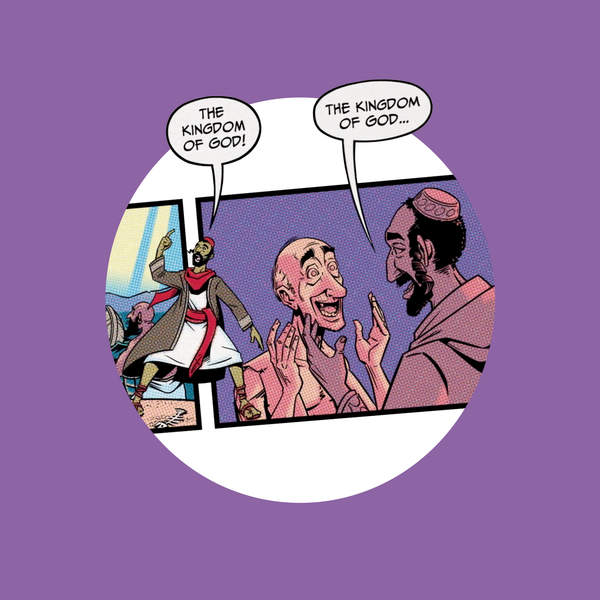
The Gospel Is More Than You Think
Episode Chapters
Show Notes
In part one (0-19:00), Tim and Jon give a brief historical overview of Israel at the time Jesus was born. Israel had been under hundreds of years of military occupation by different empires. At the time of Jesus, that empire is Rome. Tim notes that the entire Jewish people would have had a sense of expectation. The Hebrew Scriptures taught them that the glory of the Jewish kingdom would return and a messiah would rescue them. This mindset—though difficult for us to imagine—was that of an ancient Jew under Roman rule at the time when the gospels were written. In part two (19:00-25:00), Tim notes that for one to declare or be declared as “messiah” while under Roman rule would have been viewed as an act of politcal insurrrection and revolution. In part three (25:00-38:45), Tim outlines the history of the word gospel, which comes from the old English word “godspel” or good tidings. This word in Greek is εὐαγγέλιον, and Tim notes that “the euangelion” is what Jesus is said to proclaim in the beginning of Mark. Mark 1:1 The beginning of the good news about Jesus the Messiah, the Son of God. Tim then notes how Paul uses the same word at the start of Romans. Romans 1:2-4 the gospel he promised beforehand through his prophets in the Holy Scriptures regarding his Son, who as to his earthly life was a descendant of David, and who through the Spirit of holiness was appointed the Son of God in power by his resurrection from the dead: Jesus Christ our Lord. Tim also shared 1 Corinthians 15:1-8. Now, brothers and sisters, I want to remind you of the gospel I preached to you, which you received and on which you have taken your stand. By this gospel you are saved, if you hold firmly to the word I preached to you. Otherwise, you have believed in vain. For what I received I passed on to you as of first importance: that Christ died for our sins according to the Scriptures, that he was buried, that he was raised on the third day according to the Scriptures, and that he appeared to Cephas,and then to the Twelve. After that, he appeared to more than five hundred of the brothers and sisters at the same time, most of whom are still living, though some have fallen asleep. Then he appeared to James, then to all the apostles, and last of all he appeared to me also, as to one abnormally born. Tim notes that Paul doesn’t have a stock phrase or answer for “what is the gospel.” Instead he tweaks the message in both of these books and offers two complimentary answers. This example from Paul should make us cautious of trying to boil down the gospel to a simple formula. If Paul didn’t really do it that way, why should we? Instead we should try to learn how to articulate the whole story of the Jewish Scriptures and distill the Gospel through that lens. In part four (38:45-44:45), Tim also brings up Paul’s speech to the Athenians in Acts 17. Acts 17:22-34 Paul then stood up in the meeting of the Areopagus and said: “People of Athens! I see that in every way you are very religious. For as I walked around and looked carefully at your objects of worship, I even found an altar with this inscription: to an unknown god. So you are ignorant of the very thing you worship—and this is what I am going to proclaim to you. “The God who made the world and everything in it is the Lord of heaven and earth and does not live in temples built by human hands. And he is not served by human hands, as if he needed anything. Rather, he himself gives everyone life and breath and everything else. From one man he made all the nations, that they should inhabit the whole earth; and he marked out their appointed times in history and the boundaries of their lands. God did this so that they would seek him and perhaps reach out for him and find him, though he is not far from any one of us. ‘For in him we live and move and have our being.’ As some of your own poets have said, ‘We are his offspring.’ “Therefore since we are God’s offspring, we should not think that the divine being is like gold or silver or stone—an image made by human design and skill. In the past God overlooked such ignorance, but now he commands all people everywhere to repent. For he has set a day when he will judge the world with justice by the man he has appointed. He has given proof of this to everyone by raising him from the dead.” When they heard about the resurrection of the dead, some of them sneered, but others said, “We want to hear you again on this subject.” At that, Paul left the Council. Some of the people became followers of Paul and believed. Among them was Dionysius, a member of the Areopagus, also a woman named Damaris, and a number of others. Tim notes that also in this presentation, Paul does not bring up Christ’s atoning death explictly. The atoning death of Christ is part of the gospel, but it is not the whole. The larger story of the Gospel is portrayed in the four books known as the Gospels. What is the larger story? It is about Jesus inaugurating the Kingdom of God. In part five (44:45-end), Tim gives his own definitions of the four books known as "the Gospels." "The Gospels are carefully designed theological biographies of Jesus of Nazareth. They focus on his announcement of the euangelion. They are not merely historical records. They are designed to advance a claim that will challenge the readers thinking and behavior, and you are going to be forced to make a decision about Jesus after reading the book. And what is the claim? That the crucified and risen Jesus of Nazareth is the Messiah of Israel and true Lord of the world." Tim closes with an insight from scholars Loveday Alexander and Richard Burridge, as well as a book called Reading the Gospels Wisely by Jonathan Pennington.
Scripture References
Referenced Resources
- Richard Burridge: What are the Gospels? A Comparision with Graeco Roman Biography.
- Loveday Alexander: The Preface to Luke’s Gospel.
- Jonathan Pennington: Reading the Gospels Wisely.
Check out Tim's library here. You can experience our entire library of resources in the BibleProject app, available for Android and iOS.

